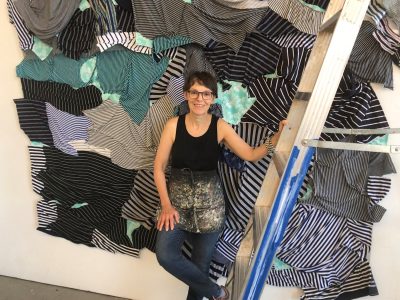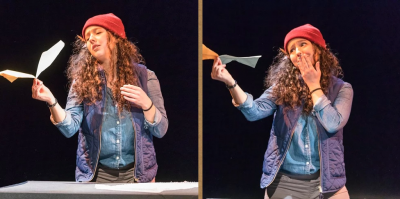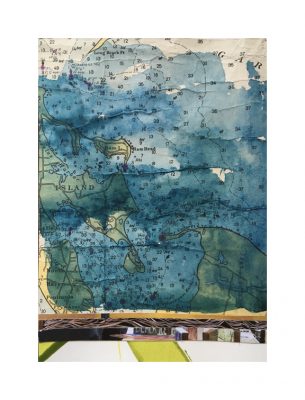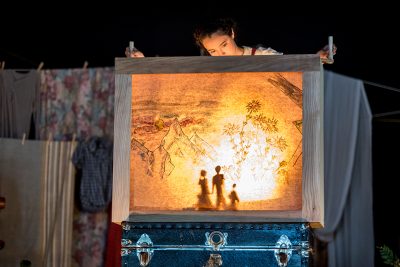
Groton — Two artists using different mediums have been awarded 2020 Connecticut Sea Grant Arts Support Awards to create works conveying messages about human connections to the sea and the threats it faces.
The two artists were chosen to each receive a $1,000 award. The awards are funded by Connecticut Sea Grant and one is being matched by the Connecticut Department of Economic Development’s Office of the Arts.
Kathryn Frund of Cheshire and Felicia Cooper of Stafford Springs were both recommended for awards by an independent Review Panel as part of the competitive CTSG Arts Support Awards Program, now in its 11th year.
For her project, Frund will build a large contour map installation of Long Island Sound, using striped fabric culled from thrift stores. These will be laid out with curves and folds atop panels to convey the movement and dimensions of the marine waters in the estuary. By using discarded clothing to depict the shape of the Sound, Frund said, she hopes to raise awareness about excess consumption as well as the impacts of climate change. There may be opportunities as well for the public to donate cast-off clothing to help raise awareness of the impacts of our consumption and facilitating an extended conversation about sustainable consumer choices.

Cooper, for her part, will create a one-hour children’s puppet musical titled, “Ish,” based loosely on Herman Melville’s classic novel Moby-Dick. The characters will travel in a submarine through the ocean, eventually encountering a great whale and becoming challenged to use their imaginations and resourcefulness to meet environmental challenges.
“The Review Panel was really impressed by the proposals of both artists on the basis of their aesthetic strength and relevance to CTSG’s mission,” said Syma Ebbin, CTSG’s research coordinator who initiated and leads the arts support program. “Frund’s work has the capacity to resonate with its audience and further our understanding of the impacts of our consumerism. Cooper’s work engages a young audience in a puppetry performance that aims to increase their awareness of ocean pollution problems and get them thinking about innovating creative solutions to these problems.”

The winning submissions were selected based on aesthetic quality, relevance to coastal and marine environments and Connecticut Sea Grant themes, as well as potential impact on non-traditional audiences. Artists who live in Connecticut or whose work is related to Connecticut’s coastal and marine environments or Long Island Sound are eligible.
Frund, who works out of a studio in New Haven, said she has long been passionate about the ocean environment and concerned about the accumulation of plastic pollution from synthetic fibers and other sources. For an earlier project titled “Contours and Rising Tides,” she depicted the five sections of the world ocean in fabric as limited ecosystems at risk. The Long Island Sound project, she said, would be a continuation of that idea, focusing on a water body located just a couple of blocks from her studio.
“I really want the piece to focus on the finite reality we have in the Sound,” she said. “It can look like a vast expanse from shore, but it’s not an endless thing we can just continue dumping in.”
She began her artistic career as a painter, but became concerned about the use of synthetic materials and waste she was generating. Now she expresses her art and environmental aesthetic using repurposed post-consumer waste, especially plastic and other synthetic materials.
In addition to the room-sized installation of the Long Island Sound map, she will also create smaller watercolor studies using vintage nautical charts of the Sound. These will express “fragility, beauty and resilience” through sustainable practices, she said. Frund plans to show the works at the Chase Young Gallery in Boston as well as at New Haven Open Studios. She is also hoping to exhibit at the Alexey von Schlippe Gallery at UConn Avery Point.
Cooper, who is studying for a Master of Fine Arts degree in Puppetry Arts at UConn, worked in children’s theater, as a teaching artist and maker of puppet shows in the Pittsburgh area for nearly a decade before coming to UConn. In “Ish,” a “resourceful, plucky, compassionate” 11-year-old girl leads a ragtag submarine crew through an ocean that is itself a character in trouble, filled with “more trash than fish.” In a reference to the pandemic, the characters will experience isolation on the submarine and use their resourcefulness to enliven their world. Similar to Frund’s project, the puppets will be made from repurposed materials.

Originally planned for live performances, Cooper has agreed to adapt her project into a solo performance that can be live streamed on YouTube, Facebook and possibly shown on large, open-area movie screens. Cooper said she is also considering offering a series of outdoor shows with limited seating. While her target audience is 6- to 11-year-olds, she said the show will appeal to “anyone who’s curious about puppets and anyone who’s experienced isolation.
“I’ll perform it more often, but for smaller and safer audiences,” she said.
Working with Cooper on the show will be composer Juliana Carr. The pair have collaborated on two other shows in the past. In all her puppetry works, Cooper said, she tries to convey a message about an issue in need of attention.
“My work is very community based,” she said. “I always try to work with a group that needs to have its voice heard, or to represent the environment.
Ebbin said both projects will help fulfill the purpose of the arts grant to expand CTSG’s outreach.
“The CTSG Arts Award Support program was created to broaden CTSG’s reach and audience in achieving the goals of its Strategic Plan, engaging audiences differently and perhaps, more effectively than through traditional modes of outreach,” she said. “Evoking emotional responses may be a more direct way of eliciting behavior change and promoting stewardship, and research suggests that the arts seem to have the capacity to achieve these ends.”
For information about the Connecticut Sea Grant Arts Support Awards program, visit: https://seagrant.uconn.edu/?p=4566.
For more information about the 2020 Arts Support Award recipients, contact Judy Benson, CTSG communications coordinator, at: judy.benson@uconn.edu or at (860) 287-6426. Connecticut Sea Grant is based at UConn’s Avery Point campus in Groton.